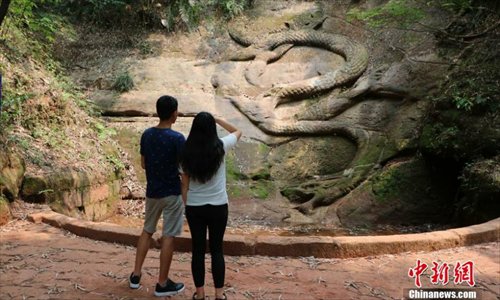Rare discovery: Stone carvings in Hubei Province confirm popularity of paper money in China over 600 years ago
Source:Global Times Published: 2020/6/14 17:18:40

Located in Jiangkou township of southwest China's Sichuan province, the 17.4-meter-long stone dragon dates back to Song Dynasty (960-1279). As the stone carving had been exposed to the elements, it was covered with mud and weeds. The local government started a renovation project on the stone dragon in March, and the work has completed in May. Photo: Chinanews.com
A research team in Central China's Hubei Province has discovered stone inscriptions carved on a cliff on Wudang Mountain, one of the "Four Sacred Mountains of Taoism," showing that paper money was widely used during the Yuan Dynasty (1279-1368).
The stone inscriptions, which were discovered on June 6, record the donation of paper money by a businessman to the construction of the foundation of a grotto on the mountain in 1332, The Beijing News reported on Sunday.
Li Wanjing, a member of the Hubei Institute of Cultural Relics archaeological team, said that based on the inscriptions they deduced that paper money was commonly used among ordinary people during the Yuan Dynasty and that the commodity economy was relatively developed.
Li told The Beijing News that such a novel discovery is rare.
Chinese netizens called for the stone inscriptions to be protected, since such carvings can be easily damaged by the weather or tourists.
"The discovery can provide material for research into the social and economic activities of the Yuan Dynasty and should be protected," one netizen posted on China's Twitter-like Sina Weibo.
Paper money originated around 1008 in China as a form of promissory note called jiaozi (Lit: exchanger). According to historic records, a businessman surnamed Wang in Chengdu, Southwest China's Sichuan Province invented the novel means of exchange, according to a report from Sina News.
Wang convened a meeting with 16 other merchants, who agreed to use paper printed with the same patterns and various numbers as a currency during exchanges.
The ease at which this paper currency could be carried made it an immediate hit among merchants, who often needed to travel extensively.
Its popularity among the general populace made the government at the time take notice, which helped ease its management. Therefore, the government of Northern Song Dynasty (960-1127) released the first official jiaozi in 1024 and established an agency to regulate the issuance of paper currency.
RELATED ARTICLES:
Posted in: ART,ARTS FOCUS